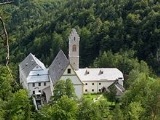
St. Georgenberg-Fiecht Abbey
Encyclopedia
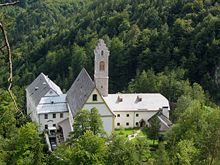 |
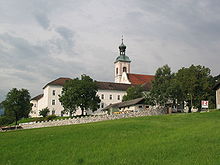 |
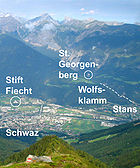
Vomp
Vomp is a municipality in the Schwaz district of Tyrol, Austria....
in Tyrol
Tyrol (state)
Tyrol is a state or Bundesland, located in the west of Austria. It comprises the Austrian part of the historical region of Tyrol.The state is split into two parts–called North Tyrol and East Tyrol–by a -wide strip of land where the state of Salzburg borders directly on the Italian province of...
, Austria
Austria
Austria , officially the Republic of Austria , is a landlocked country of roughly 8.4 million people in Central Europe. It is bordered by the Czech Republic and Germany to the north, Slovakia and Hungary to the east, Slovenia and Italy to the south, and Switzerland and Liechtenstein to the...
; a pilgrimage church still stands on the original site on the Georgenberg. Founded in 1138, it is the oldest extant monastery in the Tyrol.
History

.gif)
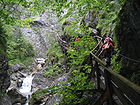
Bad Aibling
Bad Aibling is a spa town and former district seat in Bavaria on the river Mangfall, located some 35 miles southeast of Munich. It is a health resort .-History:...
, of the ancient noble family of the Rapotonen, who established his cell on the Georgenberg ("St. George's Mount"), a rocky outcrop rising some hundred metres above the Stallental valley near Stans
Stans, Austria
Stans is a municipality in the Schwaz district of Tyrol, Austria. It is located in the Inn valley, some 3 km away from the district town of Schwaz....
.
Substantial donations to the community as early as 1000 or thereabouts from Albuin, Bishop of Brixen
Bishopric of Brixen
The Bishopric of Brixen is a former Roman Catholic diocese and also a former ecclesiastical state of the Holy Roman Empire in the present province of South Tyrol. The bishopric in the Eisack/Isarco valley was established in the 6th century and gradually received more secular powers...
, and in 1097 from Emperor Henry IV
Henry IV, Holy Roman Emperor
Henry IV was King of the Romans from 1056 and Holy Roman Emperor from 1084 until his forced abdication in 1105. He was the third emperor of the Salian dynasty and one of the most powerful and important figures of the 11th century...
suggest that by that time there was already a well-established monastery here rather than a simple hermitage.
The religious community at St. Georgenberg was turned into a Benedictine abbey in 1138 by Reginbert, Bishop of Brixen; the papal charter of confirmation is dated 30 April 1138.
On 31 October 1705 there occurred the fourth in a series of disastrous fires which ruined all the buildings, and the abbey was moved to a new site at Fiecht in the Inn
Inn River
The Inn is a river in Switzerland, Austria and Germany. It is a right tributary of the Danube and is approximately 500km long. The highest point of its drainage basin is the summit of Piz Bernina, at 4,049 metres.- Geography :...
valley. It became operative again in 1708.
Because of lack of funds, however, the new conventual buildings and church (begun in 1741 and finished in 1750; its tower was finished as late as 1781) were uniquely modest in their construction, but for that very reason are the more impressive as examples of Baroque architecture
Baroque architecture
Baroque architecture is a term used to describe the building style of the Baroque era, begun in late sixteenth century Italy, that took the Roman vocabulary of Renaissance architecture and used it in a new rhetorical and theatrical fashion, often to express the triumph of the Catholic Church and...
. Only the inside of the church and the trompe l'oeil
Trompe l'oeil
Trompe-l'œil, which can also be spelled without the hyphen in English as trompe l'oeil, is an art technique involving extremely realistic imagery in order to create the optical illusion that the depicted objects appear in three dimensions.-History in painting:Although the phrase has its origin in...
façade, only visible from the monastic buildings, were finished in the typical style of the era: stuccoists of the Wessobrunn School, such as Franz Xaver Feuchtmayer the Elder
Franz Xaver Feuchtmayer
Franz Xaver Feuchtmayer was a German Baroque stucco plasterer of the Wessobrunner School.A member of the famous Feuchtmayer family, he was the son of Michael Feuchtmayer Franz Xaver Feuchtmayer (the Elder) (1698, Wessobrunn, Bavaria – 1763) was a German Baroque stucco plasterer of the...
and his brother Michael, the frescoist Matthäus Günther
Matthäus Günther
Matthäus Günther was an important German painter and artist of the Baroque and Rococo era....
and other renowned sculptors from the Tyrol and elsewhere were engaged for these parts of the construction.
Ater the Treaty of Pressburg in 1806 the Tyrol was passed from Austria to Bavaria
Bavaria
Bavaria, formally the Free State of Bavaria is a state of Germany, located in the southeast of Germany. With an area of , it is the largest state by area, forming almost 20% of the total land area of Germany...
, and Fiecht Abbey was suppressed by the Bavarian government in 1807, but was restored in 1816, when the Tyrol again became part of Austria. It suffered from another serious fire in 1868 which ruined most of the collection of graphic art, but spared most of the library.
Between 1941 and 1945 the abbey was impounded by the Gestapo
Gestapo
The Gestapo was the official secret police of Nazi Germany. Beginning on 20 April 1934, it was under the administration of the SS leader Heinrich Himmler in his position as Chief of German Police...
and the monks were exiled, to return after the end of the World War II
World War II
World War II, or the Second World War , was a global conflict lasting from 1939 to 1945, involving most of the world's nations—including all of the great powers—eventually forming two opposing military alliances: the Allies and the Axis...
.
Since 1967 the abbey has been a member of the Ottilien Congregation
Ottilien Congregation
The Ottilien Congregation, often also known as the St. Ottilien Congregation and as the Missionary Benedictines, is a congregation of religious houses within the Benedictine Confederation, the aim of which is to combine the Benedictine way of life with activity in the mission field.-History:The...
(Missionary Benedictines) of the Benedictine Confederation
Benedictine Confederation
The Benedictine Confederation of the Order of Saint Benedict is the international governing body of the Order of Saint Benedict.-Origin:...
.
Pilgrimage churches on the Georgenberg
Pilgrimages here began around 1100 and increased after the "blood miracle" that is reported to have happened in about 1310. The main objects of veneration are Saint GeorgeSaint George
Saint George was, according to tradition, a Roman soldier from Syria Palaestina and a priest in the Guard of Diocletian, who is venerated as a Christian martyr. In hagiography Saint George is one of the most venerated saints in the Catholic , Anglican, Eastern Orthodox, and the Oriental Orthodox...
, a Gothic Pietà
Pietà
The Pietà is a subject in Christian art depicting the Virgin Mary cradling the dead body of Jesus, most often found in sculpture. As such, it is a particular form of the Lamentation of Christ, a scene from the Passion of Christ found in cycles of the Life of Christ...
sculpture from about 1415 and the reliquary
Reliquary
A reliquary is a container for relics. These may be the physical remains of saints, such as bones, pieces of clothing, or some object associated with saints or other religious figures...
of the Holy Blood. The present Baroque church, dedicated to Saints George and James, was built after the 1705 fire on the site and to the approximate ground plan of the old church. The new building was finished in 1735, with further alterations in 1863 (frescoes) and 1866.
The Lindenkirche, a small church dedicated to Saint Mary, existed as a stone building from about 1230 and housed the Pietà until it was transferred to the larger rebuilt church of Saints George and James in 1736. Major changes to the building were made in 1759 and 1882, but its Romanesque
Romanesque architecture
Romanesque architecture is an architectural style of Medieval Europe characterised by semi-circular arches. There is no consensus for the beginning date of the Romanesque architecture, with proposals ranging from the 6th to the 10th century. It developed in the 12th century into the Gothic style,...
porch is still intact.
As otherwise there would be no access to the monastery except by strenuous climbing, a bridge was constructed by the 15th century, which had to be restored by 1709, after the great fire. Its name is the Hohe Brücke ("high bridge"). When walking up from Stans, however, many pilgrims still take the route that leads through the romantic Wolfsklamm gorge.

